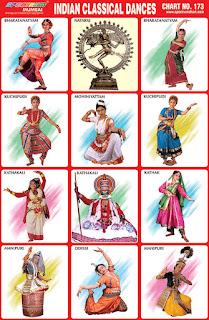Bharat Natyam
- Bharat Natyam is a form of Indian classical dance that
originated in the temples of Tamil Nadu. Bharatnatyam dance is
almost 2,000 years old. It is believed that Bharatnatyam was
revealed by Lord Brahma to Bharata, a famous sage who then codified
this sacred dance in a Sanskrit text called the Natya Shastra. The
Natya Shastra is one of the fundamental treatises on Indian drama
and aesthetics.
Kuchipudi
- Kuchipudi is one of the classical dance forms of the South
India. Kuchipudi derives its name from the Kuchipudi village of
Andhra Pradesh. Kuchipudi exhibits scenes from the Hindu Epics,
legends and mythological tales through a combination of music, dance
and acting. Like other classical dances, Kuchipudi also comprises
pure dance, mime and histrionics but it is the use of speech that
distinguishes Kuchipudi's presentation as dance drama.
Mohini Attam
- Mohiniattam is a classical dance form of Kerala. Believed
to have originated in 16th century CE, it is one of the eight Indian
classical dance forms recognised by the Sangeet Natak Akademi. It is
considered a very graceful form of dance meant to be performed as
solo recitals by women. Mohiniattam dance in Kerala developed in the
tradition of Devadasi system, which later grew and developed a
classical status.
Kathakali
- Kathakali is the classical dance form of Kerala. Kathakali
is known for its heavy, elaborate makeup and costumes. In fact, the
colourful and fascinating costumes of Kathakali have become the most
recognised icon of Kerala. Kathakali is considered as one of the
most magnificent theatres of imagination and creativity. Kathakali
dance presents themes derived from the Ramayana, the Mahabharata and
other Hindu epics, mythologies and legends.
Kathak
- Kathak is one of the eight forms of Indian classical dance.
This dance form traces its origins to the nomadic bards of ancient
northern India, known as Kathakars or storytellers. Its form today
contains traces of temple and ritual dances and the influence of the
bhakti movement.
Manipuri
- Manipuri dance originates from Manipur, a state in
north-eastern India. Manipuri dance has its roots in that state’s
folk traditions and rituals and often depicts scenes from the life
of the god Krishna. Manipuri is characterised by smooth and graceful
movements. Female roles are especially fluid in the arms and hands,
while male roles tend to have more forceful movements. The dance may
be accompanied by narrative chanting and choral singing.
Odissi
- Odissi is one of the famous classical Indian dances from
Odisha state. It is the oldest surviving dance form of India on the
basis of archaeological evidences. It is predominantly a dance for
women, with postures that replicate those found in temple
sculptures. Odissi is a very complex and expressive dance, with over
fifty mudras commonly used.
Nataraj
- Nataraja is a depiction of the Hindu God Shiva as the
cosmic dancer who performs his divine dance (called Tandavam) to
destroy a weary universe and prepare for its renewal, by the god
Brahma who starts the process of creation.


No comments:
Post a Comment